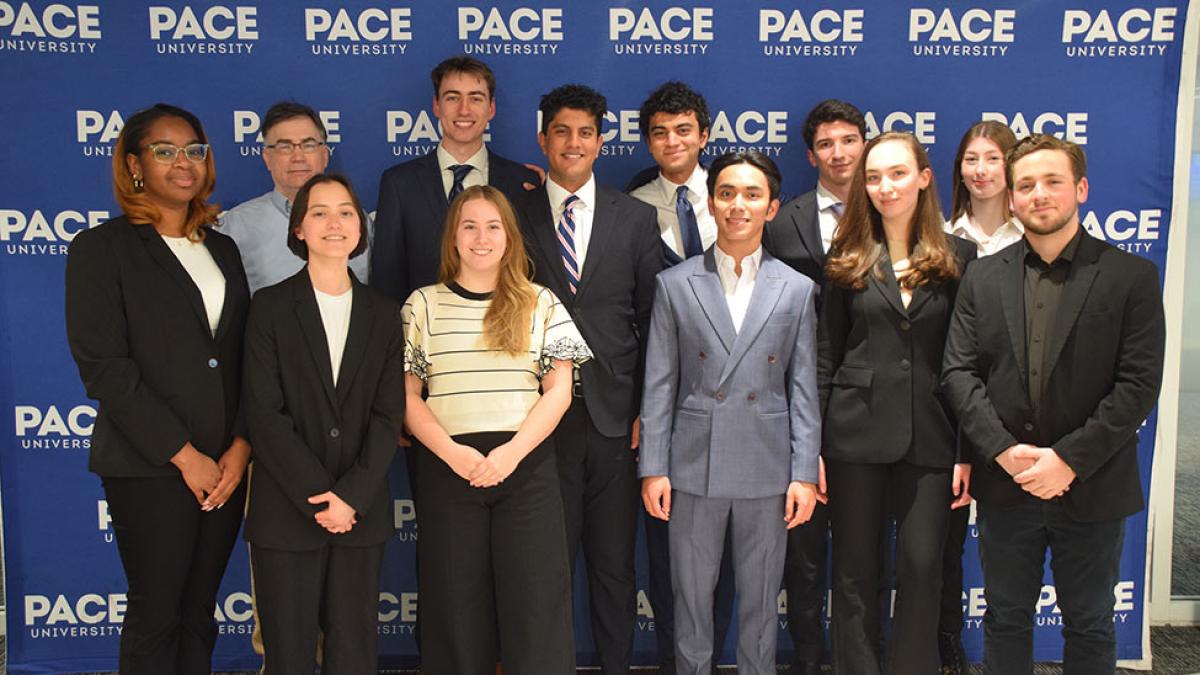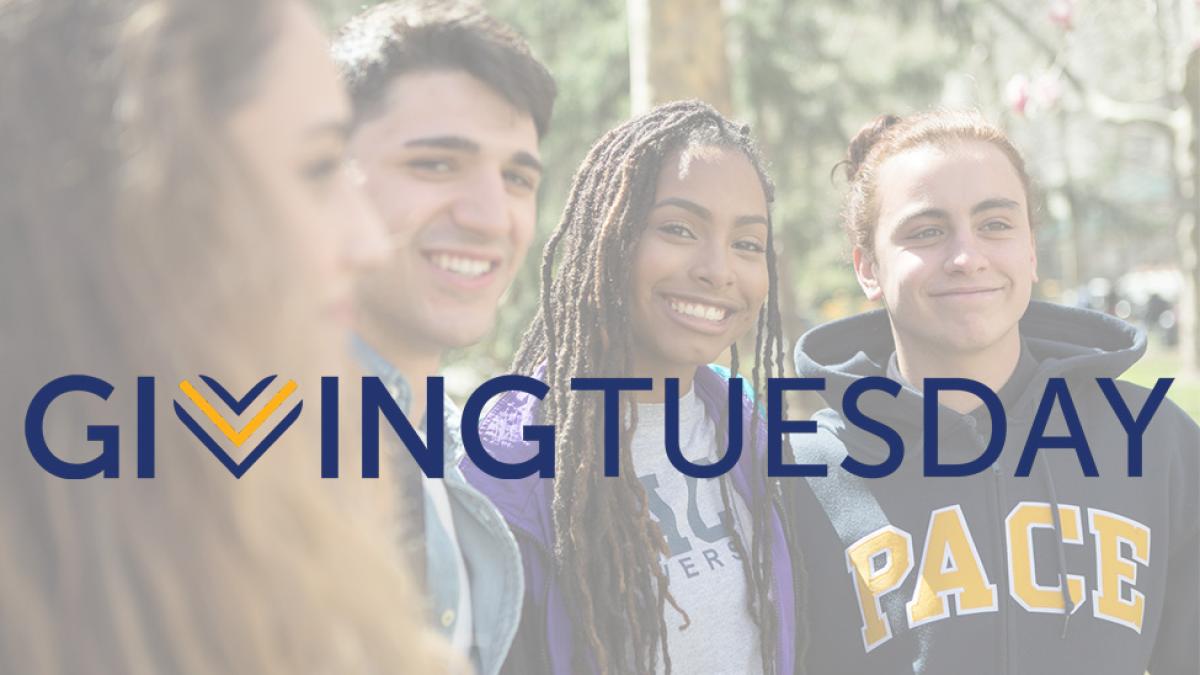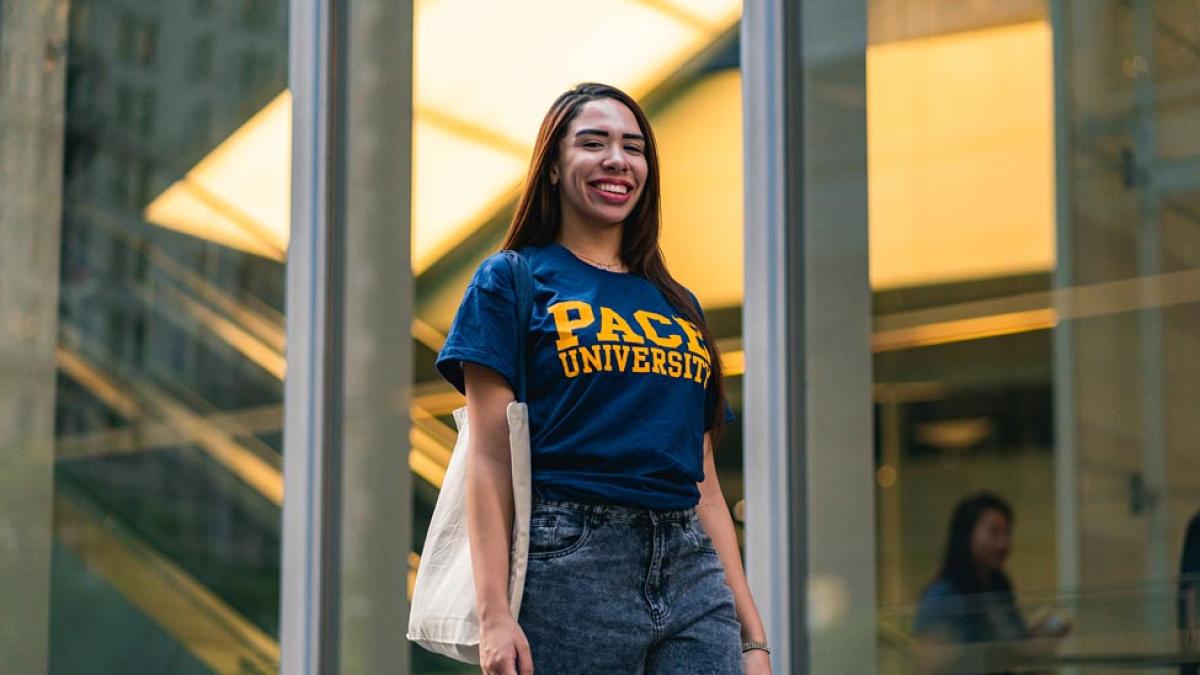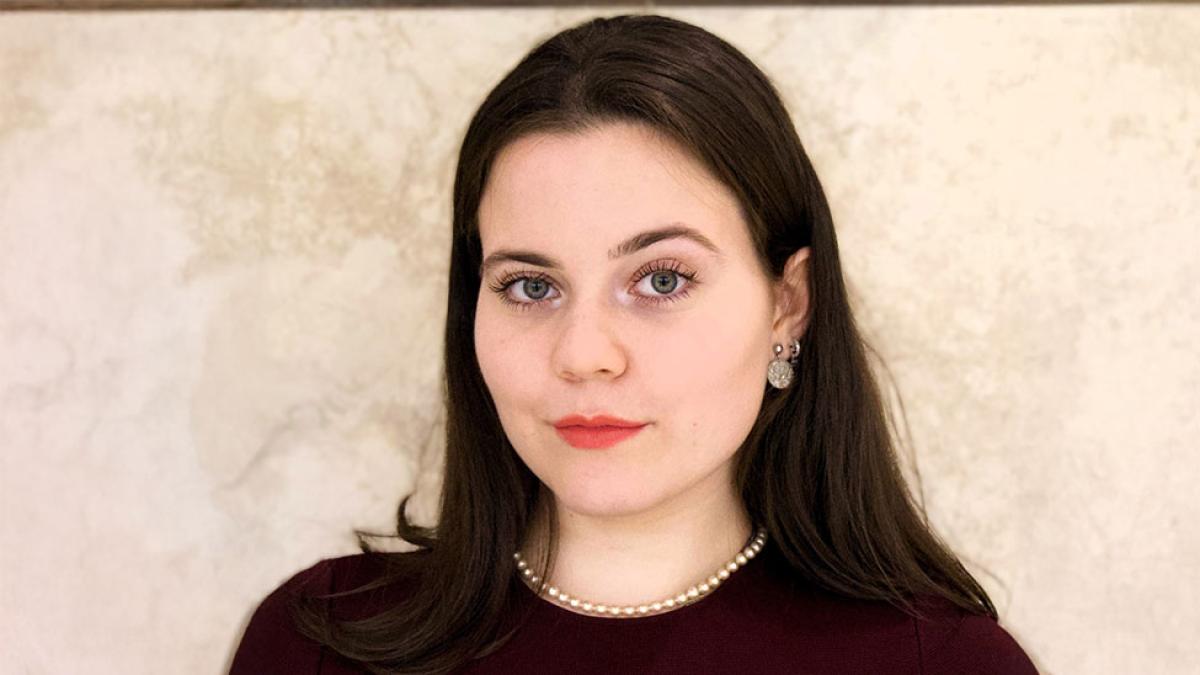Pace University was recently awarded $476,000 from the Mellon Foundation to support a three-year interdisciplinary initiative, Islands, Archipelagos, and Cultural Ecologies. The project will advance environmental justice and the environmental humanities at Pace, building on the university’s strengths in experiential learning and place-based education.
December 2024: A Playlist from President Krislov
This year, President Marvin Krislov is sharing the songs that brought joy, inspiration, and a little Broadway magic to his 2024. Whether you're wrapping up finals, savoring some much-needed downtime, or gearing up for the new year, this playlist is your perfect winter break soundtrack.
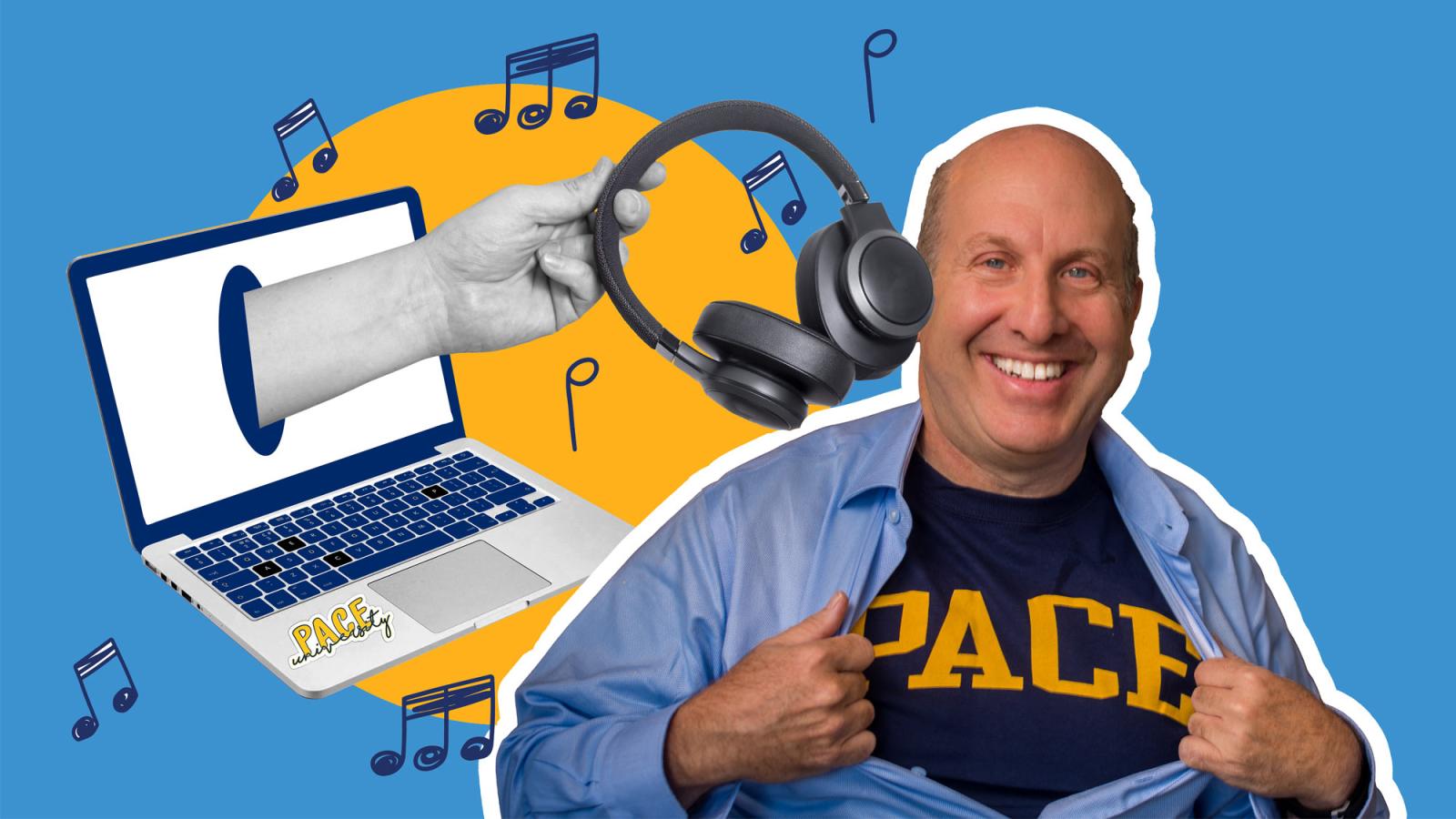
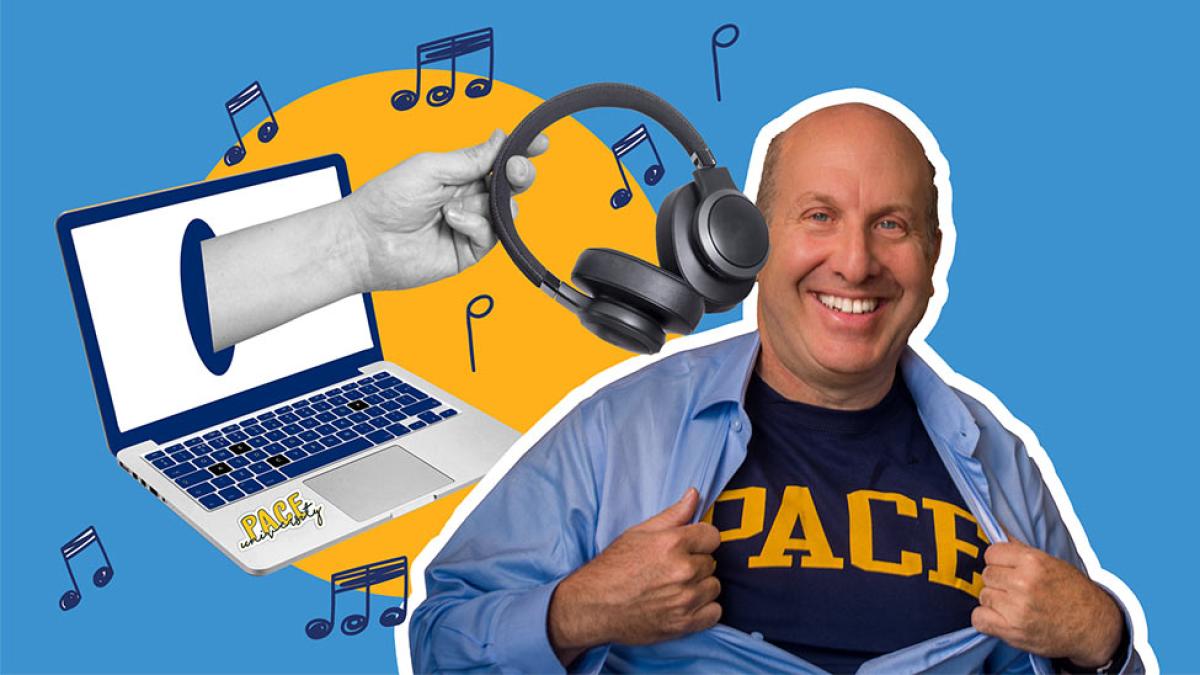
This year, President Marvin Krislov is sharing the songs that brought joy, inspiration, and a little Broadway magic to his 2024. Whether you're wrapping up finals, savoring some much-needed downtime, or gearing up for the new year, this playlist is your perfect winter break soundtrack. From show-stopping anthems to cozy holiday tunes, these are the songs that remind us of the beauty of artistry, family, and connection.
Highlights from the Playlist:
"Dancing Through Life" – Wicked
For when you're chasing your dreams and refusing to be held down (hello, Pace spirit!).
"The Times They Are a Changin’" –Bob Dylan
A nod to timeless storytelling, with lyrics that inspire deep reflection during a long winter walk.
"Texas Hold ‘Em" –Beyoncé
Because even Marvin knows: if you’re not dancing to Queen Bey, what are you doing?
"APT." –Rosé and Bruno Mars !
Because global beats remind us that inspiration transcends borders (and who doesn’t love some choreography goals?).
"Christmas in LA" –Vulfpeck
A Krislov family favorite, with a heartwarming backstory—Marvin’s cousin is part of this funky, feel-good band!
More From Pace
Pace University’s Federal Reserve Challenge Team continues its legacy of excellence, winning the 2024 New York Regional College Federal Reserve Challenge competition and ranking in the top five nationally out of 119 participating institutions— the largest in the competition’s history. The team also received an honorable mention as national finalists, competing against prestigious schools such as Harvard, Princeton, and the University of Michigan.
From criminal justice reform to entertainment industry insights and timely legal debates, our professors are making waves in podcasting. Explore three must-listen podcasts produced by Pace faculty, tackling today’s most pressing issues with expertise and passion.
Opening Doors With Genuine Connections and Authentic Interactions
Christian Campanile '26 is gaining expertise in both the legal and financial aspects of business. Seeing a gap in the student organizations on campus, he co-founded the Pre-Law Society to create a platform where students passionate about law can connect, learn, and prepare for their futures.
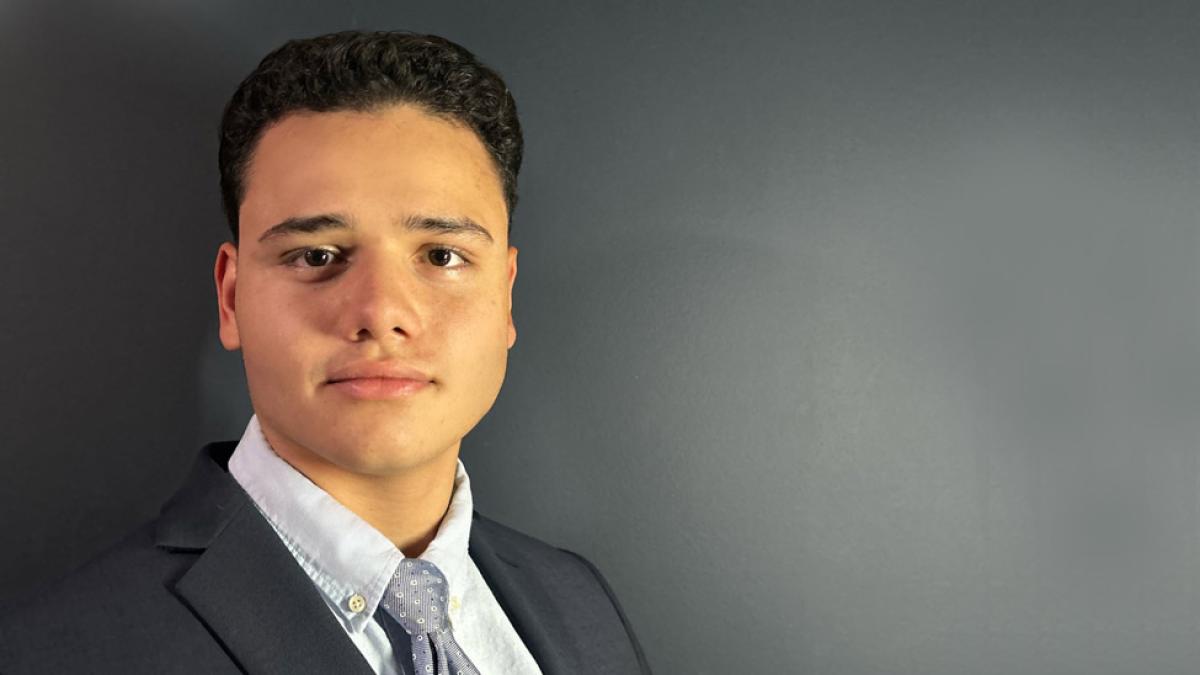
Christian Campanile
Class of 2026
Currently Studying: BBA in Finance
Member Of: Pre-Law Society (Founder and Vice President) and Undergraduate Finance Club (Alumni Relations Officer)
Pronouns: He/Him
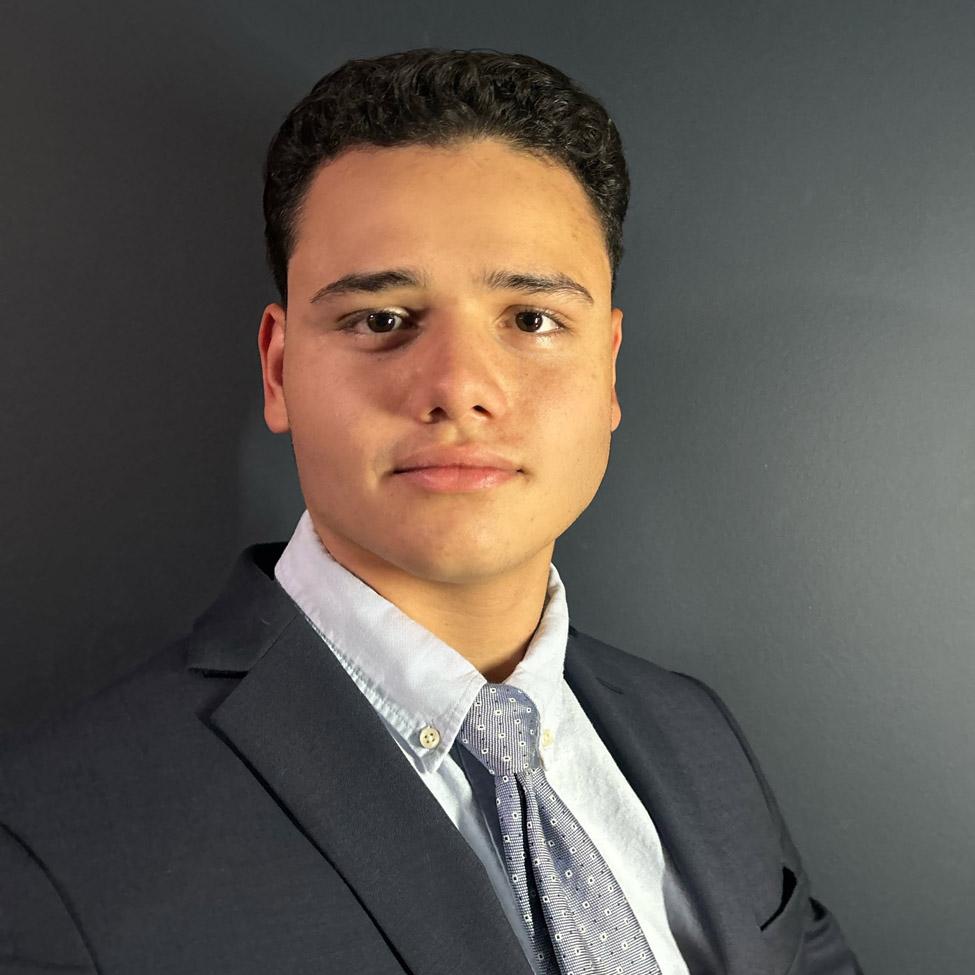
Christian Campanile is gaining expertise in both the legal and financial aspects of business. Seeing a gap in the student organizations on campus, he co-founded the Pre-Law Society to create a platform where students passionate about law can connect, learn, and prepare for their futures.
Why did you choose Pace University and the Lubin School of Business?
I chose Pace University and the Lubin School of Business because they offer unparalleled opportunities for learning and professional development. The strong connections within the alumni network and the legal and business communities in New York City are invaluable.
How have clubs on campus helped enrich your student experience?
As the Founder and Vice President of the Pre-Law Society and Alumni Relations Officer for the Undergraduate Finance Club, I have gained valuable skills in leadership, event planning, and communication. These roles have allowed me to collaborate with colleagues and club members, fostering a strong sense of community and professional growth.
What inspired you to create the Pre-Law Society at Pace?
Three others and I were inspired to establish the Pre-Law Society after realizing that no similar organization existed on campus. Our aim was to create a platform where students passionate about law could connect, learn, and prepare for their futures. We sought to foster a supportive community that would enable members to network with professionals through speaker events, gain insights into various legal fields, and develop the skills and knowledge necessary for law school. My passion for law and my commitment to helping others navigate their journeys played a significant role in my decision to co-found the Pre-Law Society.
What have you learned in your current role as the Alumni Relations Officer of the Undergraduate Finance Club?
As the Alumni Relations Officer of the Undergraduate Finance Club, I have gained valuable experience in building professional connections, coordinating events, and fostering mentorship opportunities. This role has strengthened my communication and networking skills while helping to bridge the gap between students and alumni to support career development.
What has been your favorite opportunity at Pace?
My favorite opportunity at Pace was organizing a speaker session with philanthropist and financial titan Bill Ackman. It was my first time working with multiple departments across the school and it was incredible to collaborate with such a large and dynamic team.
My advice to other Lubin students is to foster your personability. Genuine connections and authentic interactions are what truly open doors. Your ability to connect with others will not only shape your career, but also define your journey.
Do you have any advice for other Lubin students?
My advice to other Lubin students is to foster your personability. Genuine connections and authentic interactions are what truly open doors. Your ability to connect with others will not only shape your career, but also define your journey.
Describe your experience interning with the New York State Supreme Court.
My internship at the New York State Supreme Court began with an unexpected conversation during my part-time job as a waiter. I shared with a judge that I saw myself following a similar career path, which intrigued him. After a meaningful conversation, he offered me an internship. This opportunity allowed me to observe court proceedings, assist with legal research, and gain a deeper understanding of the judicial system. The experience not only strengthened my passion for the legal field, but also solidified my decision to pursue a legal career.
How will your experience at the New York State Supreme Court, in partnership with your knowledge and degree from Lubin, help you succeed post-graduation?
My internship experience, combined with the business acumen I have developed at Lubin, will provide a strong foundation for my legal career. Understanding both the legal and financial aspects of business will allow me to approach challenges with a well-rounded perspective, making me a valuable asset in any legal setting.
What does #LubinLife mean to you?
#LubinLife signifies embracing every opportunity to grow both professionally and personally. It's about being part of a community that fosters collaboration, innovation, and continuous development.
Pace Faculty Take to the Mic: Three Podcasts You Need to Hear
From criminal justice reform to entertainment industry insights and timely legal debates, our professors are making waves in podcasting. Explore three must-listen podcasts produced by Pace faculty, tackling today’s most pressing issues with expertise and passion.


At Pace University, the conversations shaping the future are happening both inside the classroom and behind the microphone. From criminal justice reform to the evolution of entertainment and timely legal debates, faculty members are bringing their expertise to podcasting platforms to spark ideas, share knowledge, and inspire action. Here’s a closer look at three podcasts hosted by Pace professors that are tackling today’s most pressing issues with passion, insight, and a unique Pace perspective.
Justice Brewed Fresh
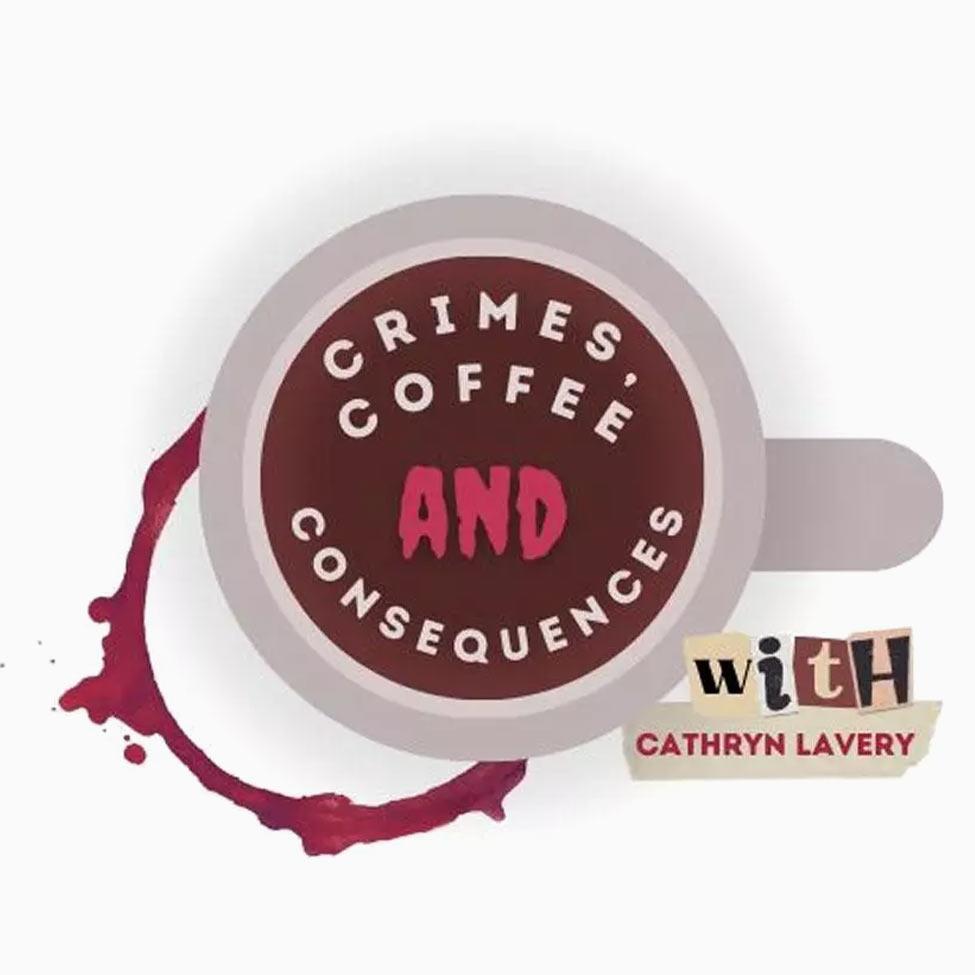
Crimes, Coffee, and Consequences, hosted by Pace Criminal Justice Professor Cathryn Lavery, PhD, dives deep into the pressing issues shaping criminal justice today. This thought-provoking podcast explores topics such as infamous cases, criminal justice reform, and cold case investigations, all through diverse lenses and perspectives. Each episode delivers compelling discussions with experts and professionals, offering listeners unique insights into the complexities of crime and its societal impact.
In the latest episode, Lavery sits down with Ramón Emilio Fernández, PhD, associate professor of Mathematics at Pace, to tackle the critical connection between K-12 education policies and youth vulnerability to crime. Professor Fernández reveals how systemic educational shortcomings, like prioritizing graduation rates over quality, have led to increased dropout rates and criminal activity. His insights underscore the urgent need for transparent, equitable, and effective educational practices to prevent these outcomes.
This season, Crimes, Coffee, and Consequences takes listeners on a journey through cold case investigations, the mental health challenges faced by first responders, and the grim realities of human trafficking. It’s the perfect blend of compelling storytelling and rigorous exploration for true crime buffs and justice advocates alike.
Catch Crimes, Coffee, and Consequences on Spotify, follow along on Instagram, and join the conversation on Facebook. Have an episode idea? Email your suggestions to CrimesCoffeeandConsequences@gmail.com.
In The Podlight Sheds New Perspectives on Entertainment
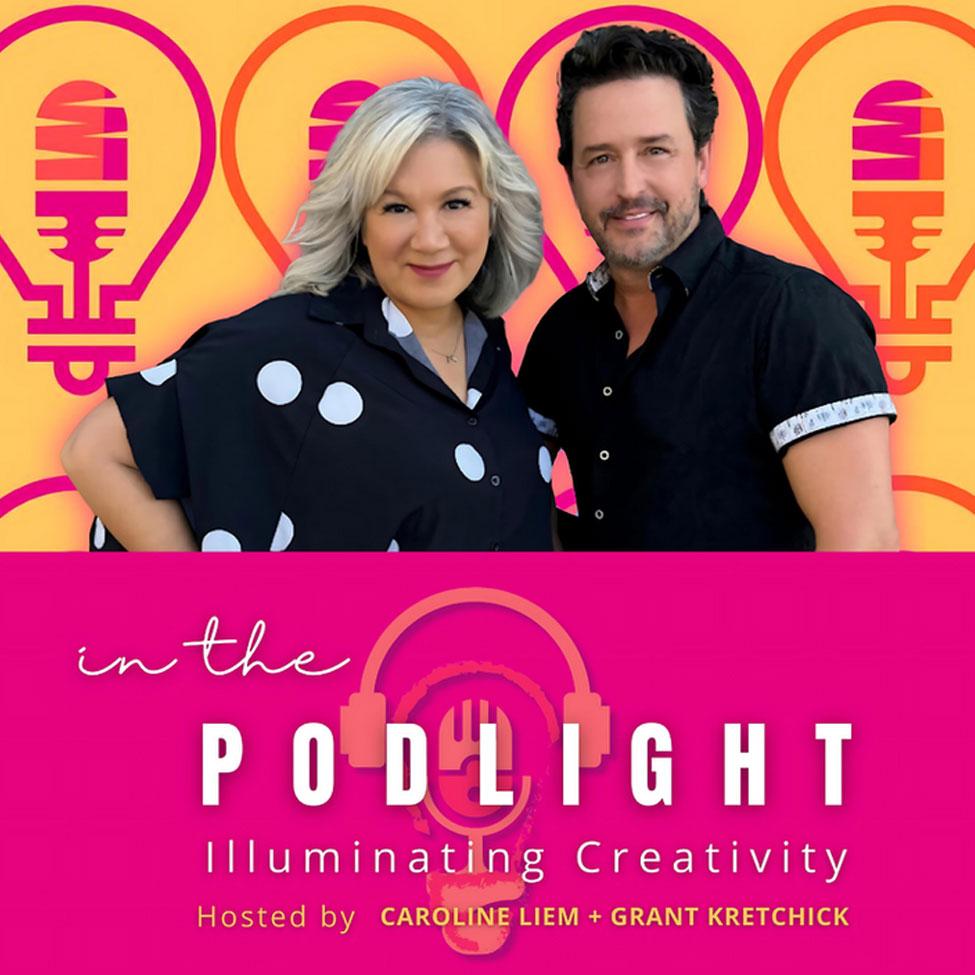
Step into the dynamic and ever-evolving world of entertainment with In The Podlight, the must-listen podcast from Sands College of Performing Arts. This series dives into the post-pandemic entertainment landscape, tackling big issues like representation, the rise of AI, union strikes, the power of streaming platforms, and the shifting economics of creativity. Featuring thought-provoking discussions led by Grant Kretchik, associate professor and department chair for BFA Acting, and Caroline Liem, an accomplished adjunct professor, the podcast brings together industry insights with a Pace University twist.
Season 1 wrapped with high-profile guest appearances from Pace alumni, including Jesse James Keitel and Liam Pearce, alongside three-time Tony Award winner and Pace honorary degree recipient LaChanze. Looking ahead, Season 2 promises even more star power with guests like alumni Cooper Koch and Dominique Fishback.
You can catch In The Podlight on Spotify, Apple Podcasts, and Amazon Music under the Sands Talks Channel. Ready to explore the challenges and triumphs shaping today's entertainment industry? Tune in and be inspired by voices driving change.
Legal Tenzer Tackles Today’s Top Legal Topics
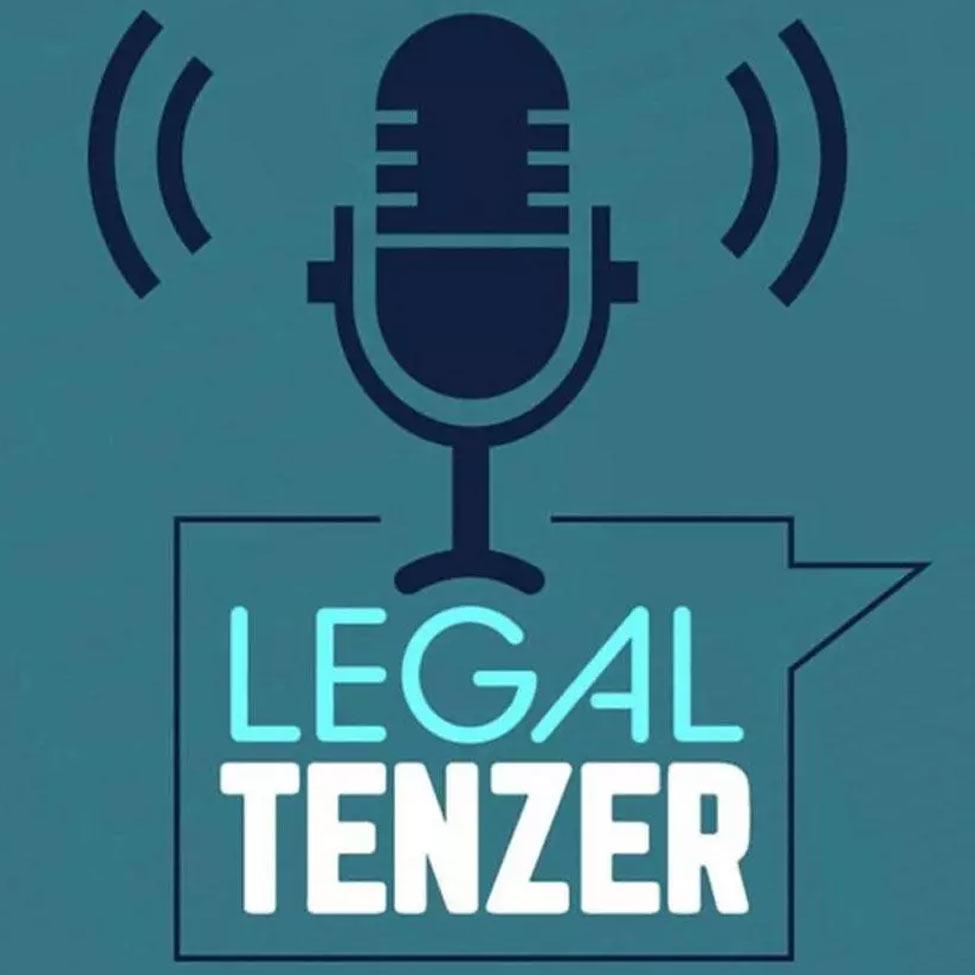
Join the conversation shaping today’s legal landscape with Legal Tenzer: Casual Conversations on Noteworthy Legal Topics. Hosted by Professor Leslie Y. Garfield Tenzer of the Elisabeth Haub School of Law at Pace University, this engaging podcast dives into the legal issues that matter most. In partnership with West Academic, this series offers thought-provoking dialogues with prominent legal scholars and practitioners, exploring timely and complex legal issues in an approachable, conversational format.
Whether discussing cutting-edge developments in the field or diving into the practicalities of law in action, Legal Tenzer delivers diverse perspectives and invaluable insights that resonate with legal professionals and enthusiasts alike. Building on the success of her foundational podcast, Law to Fact, which focuses on guiding law students through substantive legal topics, Legal Tenzer expands the conversation to broader audiences, offering fresh takes on contemporary legal challenges.
Looking for a podcast that connects you to the pulse of the legal profession? Tune in to Legal Tenzer on Spotify for compelling discussions and practical wisdom that keep you informed and inspired.
More From Pace
The Pace Community's incredible generosity on Giving Tuesday surpassed our goal, resulting in 2,674 gifts and more than $768,822 raised for student success.
Fall 2025 registration is here, and with it comes excitement, planning, and sometimes a bit of confusion. Let’s break down common myths and get the facts straight so you can register with confidence and stay on track for success.
Kristina Krichmaryov '26 found her passion with Computational Economics. She highlights the unique community of predominantly female students and the numerous opportunities for intellectual growth and leadership.
Changing the Narrative: Q+A with Nate Augustin
Nate Augustin ’27, a Writing for Diversity and Equity in Theater and Media major, shares how Pace University became the perfect platform for his voice, his transformative experiences in the program, and his hopes for creating inclusive spaces in theater and media.
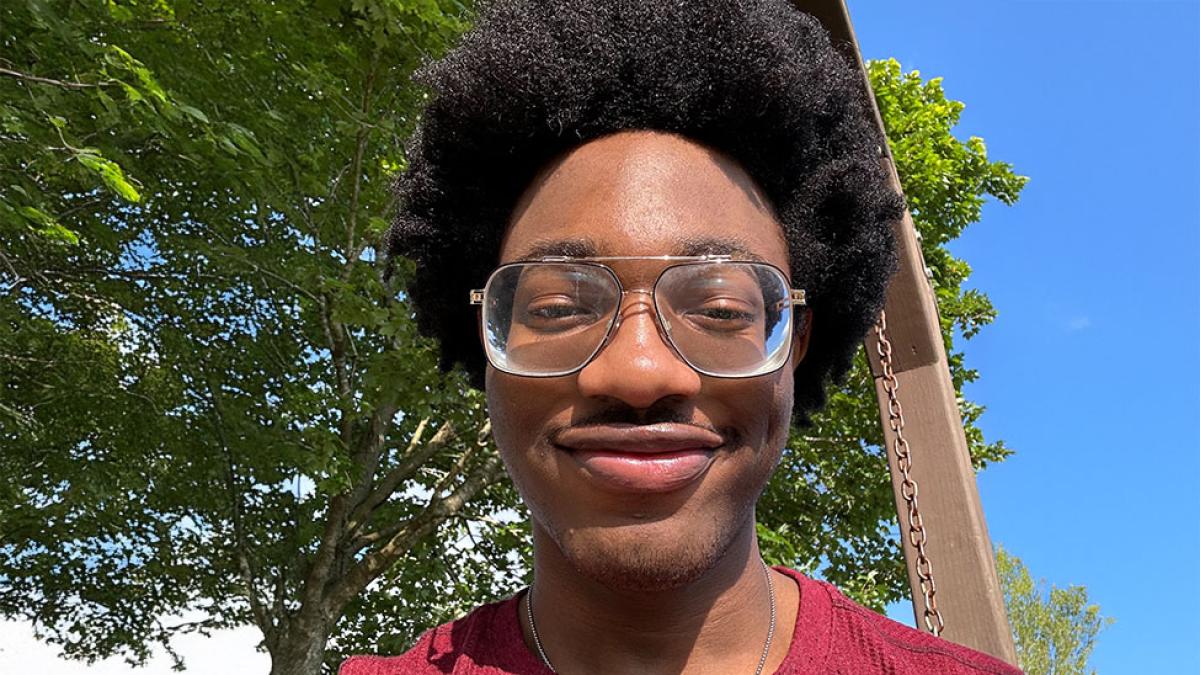
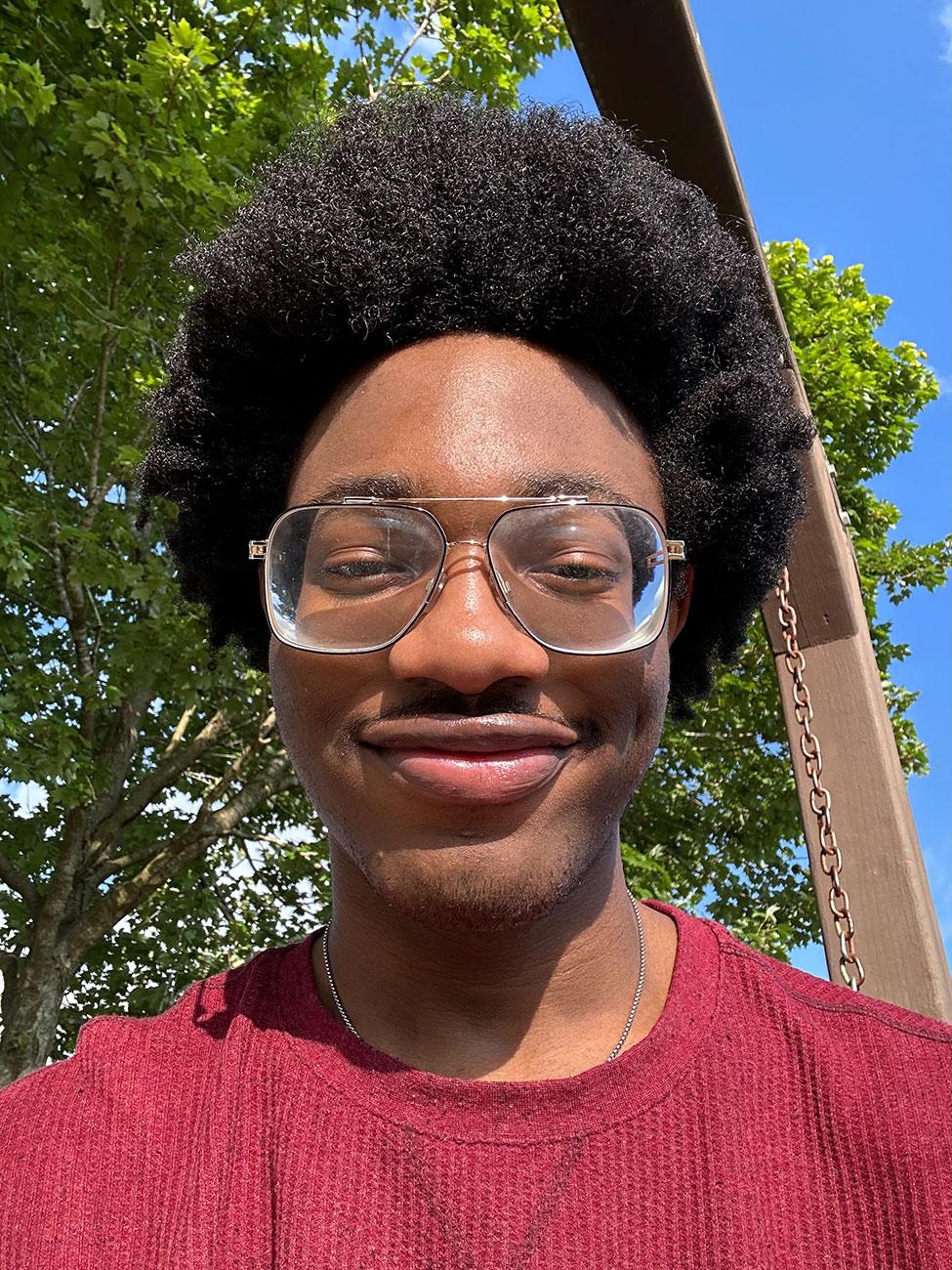
Nate Augustin
Class of 2027
BA in Writing for Diversity and Equity in Theater and Media
How did you become interested in pursuing a BA in Writing for Diversity and Equity in Theater and Media?
I’ve always had a deep passion for theater and storytelling. I love to write stories; I love to write people. Ultimately, I just have a story in my heart—a story much too passionate to contain. But it’s a story I struggle to tell, to find space for, because the entertainment industry has been so white-centric for decades, and my story does not always fit in their spaces. There are rules, expectations, and limitations imposed upon us all, but its adverse effects impact marginalized groups at a much worse rate. So, I struggle to tell my story in the way that feels right.
When I found this program at Pace, it wasn’t as though my pen had suddenly wielded a new, mystical power. But the fact that it exists at Pace means that I can exist in the world I want to exist in. I can exist in New York theater and not be what is expected of me; I can be less than gold; I can be more than product. I can be me, and my story can exist. The BA in Writing for Diversity and Equity in Theater and Media makes me hopeful. At times, when I felt that I would never tell my story, it made me feel like I could. I know that if I can, the next person can, too.
Why did you choose to attend Pace?
I chose to attend Pace because this was the only place where I thought I would feel “right.” And at Pace, I knew I was going to be somewhere where I was not alone in that feeling. I could make the most of this school, especially as it’s in New York City, the heart of American theater.
The BA in Writing for Diversity and Equity in Theater makes me hopeful. At times when I felt that I would never tell my story, it made me feel like I could. I know that if I can, the next person can, too.
What have your experiences been like in this program? How have faculty or others been influential in your journey?
I have found this program to be very welcoming. Originally from Atlanta, Georgia, and a first-generation college student, I was kind of overwhelmed to begin college and in a new city, but the students, administrators, and faculty in this program did their best to make sure I felt at home. Seeing the work they put into it is not only inspiring, but actively beneficial.
Assistant Dean S. Brian Jones is continually providing us with opportunities to showcase and produce our works, whether through workshops or events, such as a recent one called The Future of the Humanities. In addition, both he and Colby Hopkins, the program coordinator, continuously advocate for students, and a recent example of that has been securing funding for scholarships as well as for student projects for several years to come. I believe that this is only the beginning and that my experience will continually benefit from their incredible work.
What kind of activities have you been engaged in as part of this program and how have they been meaningful to you?
The workshops the program has hosted have been great, and it’s always exciting to feel like we are making a difference. An example is a DEI workshop for Pace Performing Arts (Sands College), through which I was able to witness, in real time, what happens when people who had not previously shared their voices are given a space to do so. It was so inspiring for so many.
As part of the program, we’ve also had the privilege of seeing some professional works, such as a preview of the Broadway show, How to Dance in Ohio, and it was really enlightening to witness a cast of neurodivergent actors and characters living authentically. In addition, engaging in several discussions after the shows has opened me to so many perspectives, and having a space in which we can all share and explore these experiences, their importance, and how we can improve them in our storytelling gives me hope for the future of the arts.
What other activities and organizations are you involved with at Pace?
I am a peer tutor for writing services at the Pace Learning Commons.
What would you like to do upon graduation/what are your career goals?
I plan to continue to write and produce my plays.
What advice would you like to give to our current students?
2023 was a very monumental year of change for me. I had incredible successes and devastating failures, and yet I persevered. At the beginning of 2024, I insisted on continuing to overcome previous challenges. After all, I’ve conquered them already, and why would I settle for any less? That is to say, whatever you accomplished yesterday, know you can do twice as much today.
Dumplings and Downtown: Exploring Chinatown Through NYC’s History
History tastes better with dumplings! Read about University Librarian Steve Feyl’s “Dumpling Tours” where he leads students through Chinatown, sharing NYC’s past one delicious bite at a time.

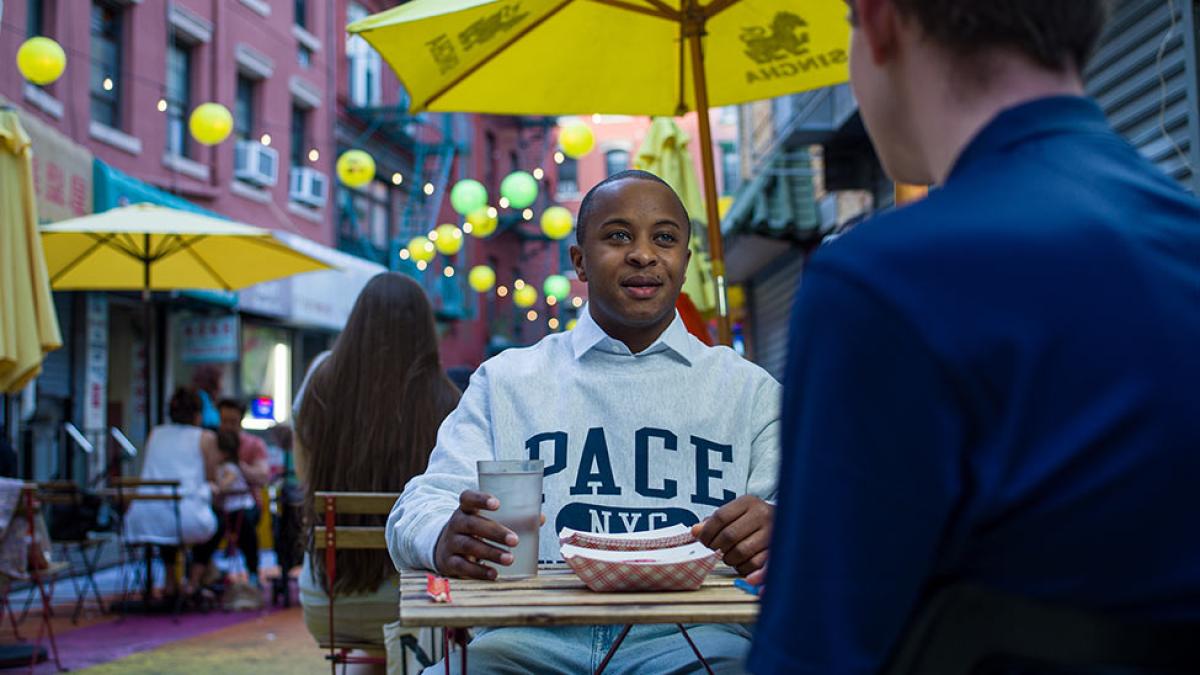
What do dumplings and Manhattan’s history have in common? For Pace University Librarian Steve Feyl, the answer lies in connection. His “Dumpling Tours” take students on a journey through Chinatown, blending delicious bites with stories of New York City’s past.

He started offering these tours in Fall 2022, following the COVID-19 pandemic. “I wanted to get students to re-engage with the library and also the local community around the New York City Campus,” Feyl shares. Students gather with Feyl outside One Pace Plaza, making their way through Chinatown to pick up dumplings before settling in for a picnic. With every stop, Feyl invites students to explore the city and its history.
Feyl’s tour weaves through the rich history surrounding Pace’s downtown campus, touching on the Lenape, Manhattan’s original inhabitants, the story behind Philadelphia-born Benjamin Franklin’s statue outside One Pace Plaza (hint: it involves publishing!), and the lasting impact of the Chinese Exclusion Act on Chinatown, including its relevance to discussions about the proposed Chinatown jail.
All the ghosts of the strange and fascinating things that happened where Pace now resides! —Feyl
A favorite story of his involves P.T. Barnum, the Brooklyn Bridge, and an elephant named Jumbo! The people of New York did not have much faith in the newly constructed Brooklyn Bridge so in 1884, P.T. Barnum convinced the city to let him march animals from his circus, led by the famous elephant Jumbo, across the bridge to prove its safety. “I try and imagine the spectacle of all those animals walking up Park Row in front of where Pace Plaza now resides and across the bridge to show that the bridge was stable,” Feyl says. “All the ghosts of the strange and fascinating things that happened where Pace now resides!”
Namitha Hebbal ’25, pursuing her MS in Marketing, Social Media, and Mobile Marketing, attended one of the tours in October with her roommate. An international student from India, Namitha explored Chinatown, discussing the difference between the tour’s dumplings and food from home, and soaked in the history of New York City. “The tour was not only was a memorable experience for us students but also a great way to give back to the communities at Chinatown which Pace is so closely located to,” says Namitha. “I absolutely loved getting to witness the passion which Steve has for history and food.”
Sometimes a common bond over something like a love of dumplings is just what you need to spur on a new friendship. —Feyl
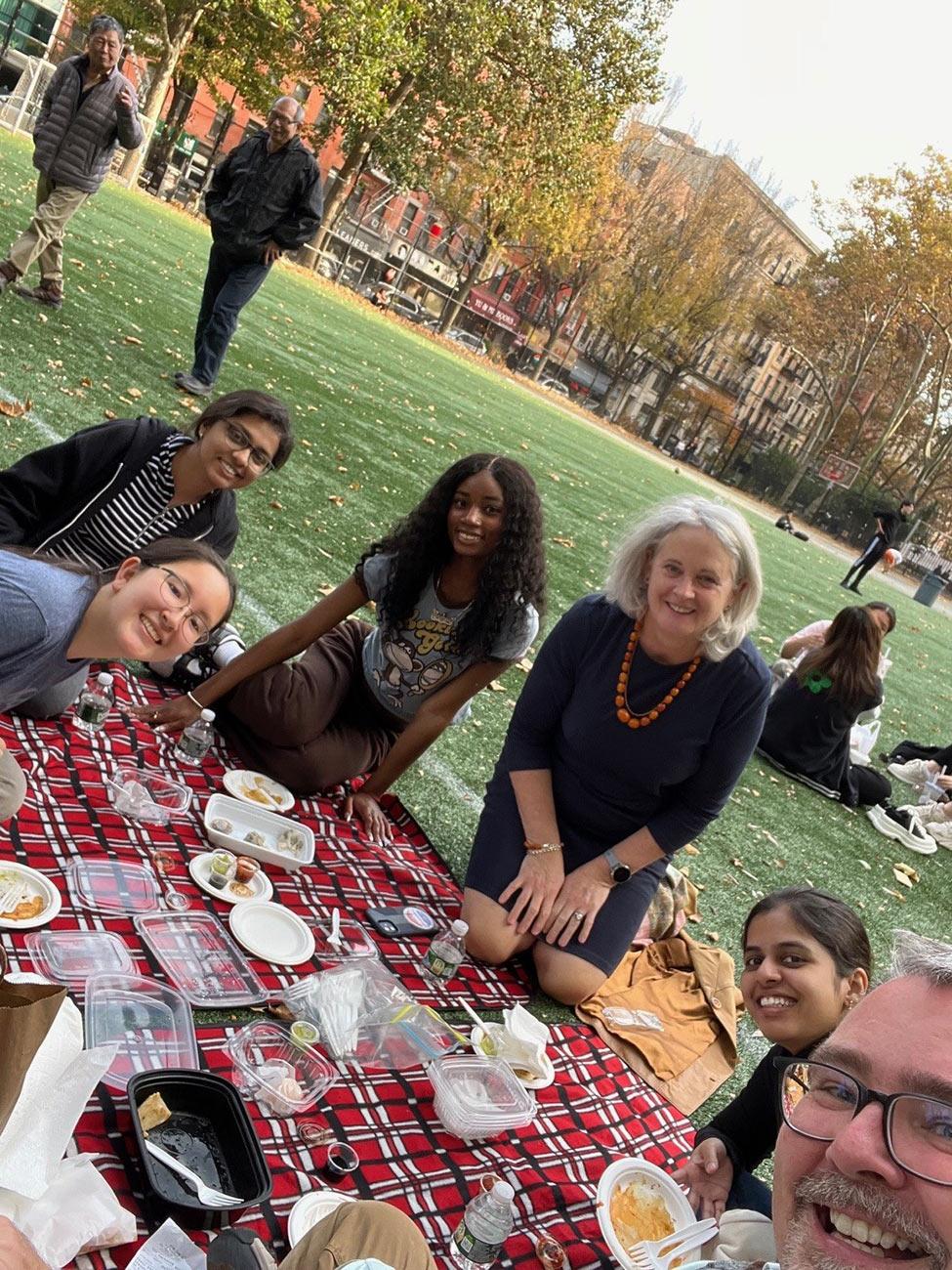
And then, of course, there’s the dumplings. The tour group picks up a variety of different dumplings prepared different ways and enjoy a picnic, comparing their favorite flavors and styles. Sometimes even stopping at Nom Wah, Chinatown’s oldest dimsum restaurant, owned for generations by Pace alumnus Wilson Tang ’00 and his family. “Who doesn’t like dumplings!” Feyl says.
But really, the dumplings are just a means to an end. They are an excuse for the journey, providing openings for connection. “Sometimes a common bond over something like a love of dumplings is just what you need to spur on a new friendship,” Feyl says. He describes how after one of his tours finished eating their dumplings, they decided to stay in Chinatown for ice cream, despite having only just met. Feyl says, “As I watched them go off on their own it made me feel so happy that perhaps the tour was the mechanism to create a bond between those students who might have gone from strangers to friends that day.”
I hope that they take away a sense of curiosity, adventurousness, and exploration. —Feyl
The tours are all about connection—Feyl even invites “celebrity guests,” Pace staff and faculty who join the fun and connect with students. In October, Vice President for Strategy and Partnerships Jean Gallagher joined the group. Reflecting on the importance of these tours, Gallagher shared, “This is our neighborhood, and students are part of the neighborhood. Not only was it great to join them in exploring our community, I appreciate the opportunity to meet students and hear about their experiences at Pace.”
Feyl hopes for his tours to not only connect students to each other and their school, but to spark a sense of wonder and curiosity in his tour participants, inspiring them to connect with the stories and lives that have shaped the city. “I hope that they take away a sense of curiosity, adventurousness, and exploration,” he says. “New York City is one of the best cities in the world, so I really try and instill these qualities into the tour and hope that it catches on with them for other adventures.”
More From Pace
Google Pier 57 was recently full of energy as over 500 tech enthusiasts (including more than 50 Pace students) gathered for GDG DevFest NYC 2024, an event dedicated to exploring “Responsible AI for the Future of Tech.” Among the organizing team was Seidenberg professor Dr. Christelle Scharff.
From criminal justice reform to entertainment industry insights and timely legal debates, our professors are making waves in podcasting. Explore three must-listen podcasts produced by Pace faculty, tackling today’s most pressing issues with expertise and passion.
Nate Augustin ’27, a Writing for Diversity and Equity in Theater and Media major, shares how Pace University became the perfect platform for his voice, his transformative experiences in the program, and his hopes for creating inclusive spaces in theater and media.
Fostering the Development of Sustainable Communities through Innovative Strategies: Highlights from the 23rd Alfred B. DelBello Land Use and Sustainable Development Conference
On December 6, 2024, the Elisabeth Haub School of Law at Pace University hosted the 23rd annual Alfred B. DelBello Land Use and Sustainable Development Conference. This year’s theme, Fostering the Development of Sustainable Communities through Innovative Strategies, brought together hundreds of attorneys, professionals, and local leaders to discuss best practices in land use and sustainable development.
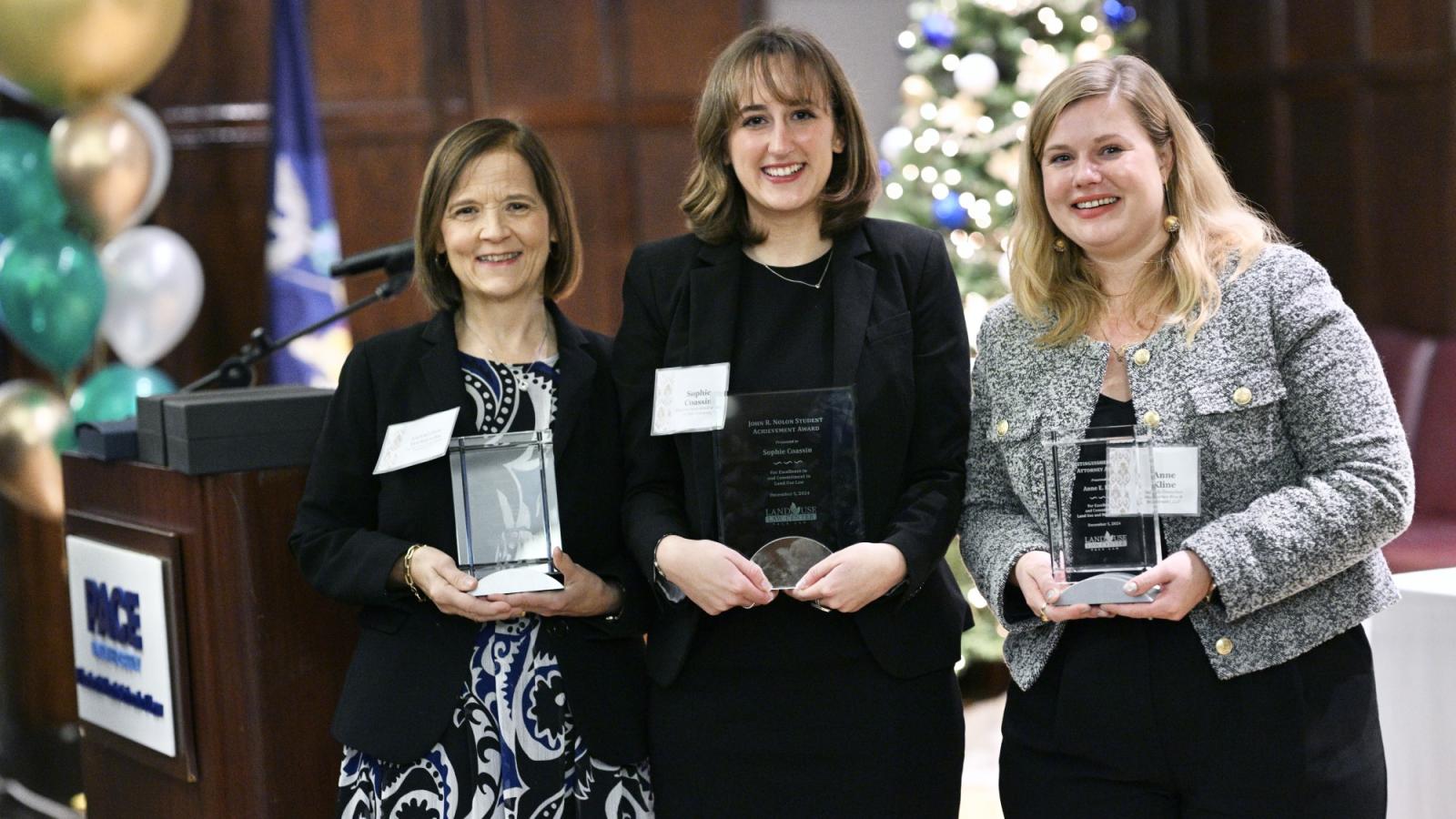
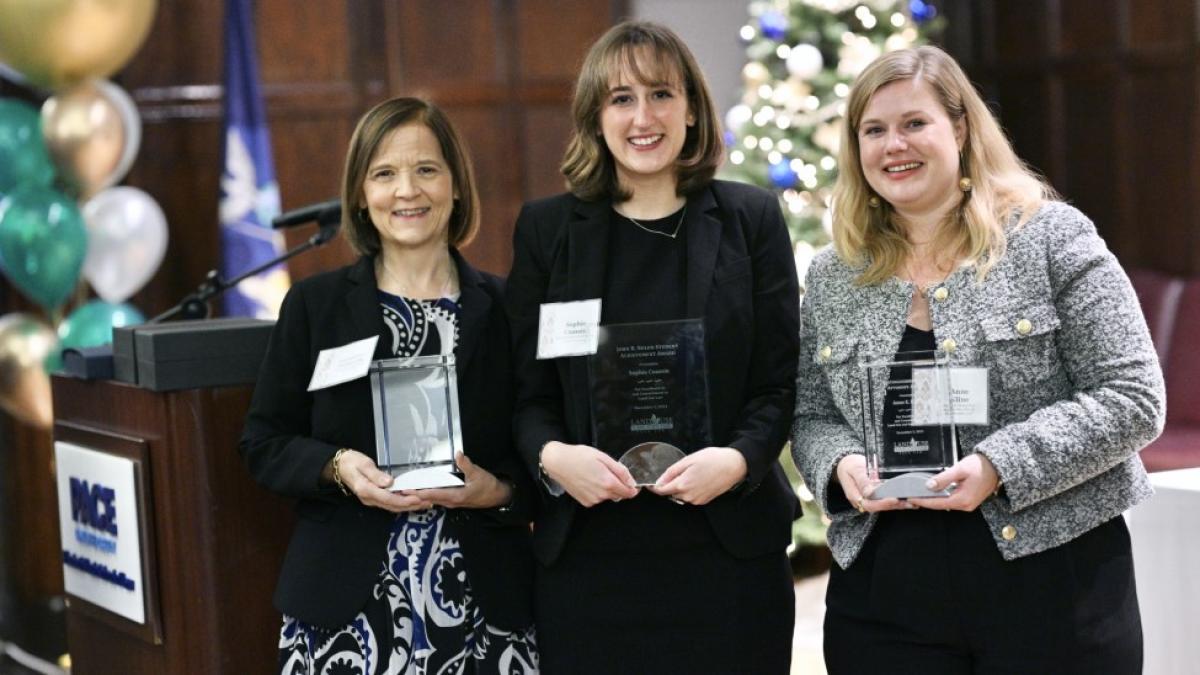
On December 6, 2024, the Elisabeth Haub School of Law at Pace University hosted the 23rd annual Alfred B. DelBello Land Use and Sustainable Development Conference. This year’s theme, Fostering the Development of Sustainable Communities through Innovative Strategies, brought together hundreds of attorneys, professionals, and local leaders to discuss best practices in land use and sustainable development.
The conference opened with remarks from Jessica Bacher, Esq., Executive Director of the Land Use Law Center, and Tiffany Zezula, Esq., Deputy Director of the Land Use Law Center, followed by ethics sessions and a morning keynote session delivered by Jerold S. Kayden, Esq., Frank Backus Williams Professor of Urban Planning and Design, Founding Director, Master in Real Estate Program, Harvard University Graduate School of Design on privately owned public spaces. Afternoon breakout sessions focused on public engagement, innovations in land use zoning, housing action plans, community preparedness and resilience.
During the conference, the annual Groundbreaker’s Award was presented to Sabrina D. Charney Hull, AICP Director of Planning, Town of New Castle, NY. As a graduate of the Land Use Leadership Alliance (LULA) Training Program, Sabrina was recognized for the exemplary work she has done in her community using the types of land use and decision-making tools and techniques taught in the LULA program.
A highlight of the conference was Chris Allen, Director of Events and Partnerships, Strong Towns, delivering an informative keynote address on Strong Towns: A Bottom-Up Revolution to Rebuild American Prosperity. During the keynote, he focused on examining why so many cities and towns across North America are “going broke”. He discussed not just why, but how we can all build and rebuild strong and resilient cities. The conference concluded with a legal update session and a wine and cheese reception.
Founder’s Award Reception and Honorees
The conference was preceded by the Founder’s Award Reception on December 5, where three individuals were honored:
- Geraldine N. Tortorella, Esq., '97, a founding partner of Hocherman Tortorella & Wekstein, LLP, received the Founder’s Award for her career-long commitment to community collaboration and positive change.
- Anne Kline ’12, an associate at DelBello Donnellan Weingarten Wise & Wiederkehr, LLP, was honored with the Distinguished Young Attorney Award for her contributions to land use and real estate law.
- Sophie Coassin, a current Haub Law student, received the John R. Nolon Student Achievement Award for her dedication and commitment to excellence in fulfilling the mission of the Land Use Law Center.
Supporting Sustainability Through Collaboration
Each year, the Conference is made possible by the generosity of a significant number of sponsors who believe in the mission of the Land Use Law Center and the importance of this annual conference. Special thanks is given to M&T Bank, top sponsor of the event, along with DelBello Donnellan Weingarten Wise & Wiederkehr, LLP, Collins Capital Partners LLC, Zarin & Steinmetz LLP, The Oram Foundation, Inc., Cuddy & Feder LLP, Hocherman, Tortorella, and Wekstein, LLP, and the Municipal Housing Authority for the City of Yonkers. For more details visit the 2024 Conference agenda program.
Seidenberg’s Impact at Google’s DevFest: Responsible AI Takes Center Stage
Google Pier 57 was recently full of energy as over 500 tech enthusiasts (including more than 50 Pace students) gathered for GDG DevFest NYC 2024, an event dedicated to exploring “Responsible AI for the Future of Tech.” Among the organizing team was Seidenberg professor Dr. Christelle Scharff.
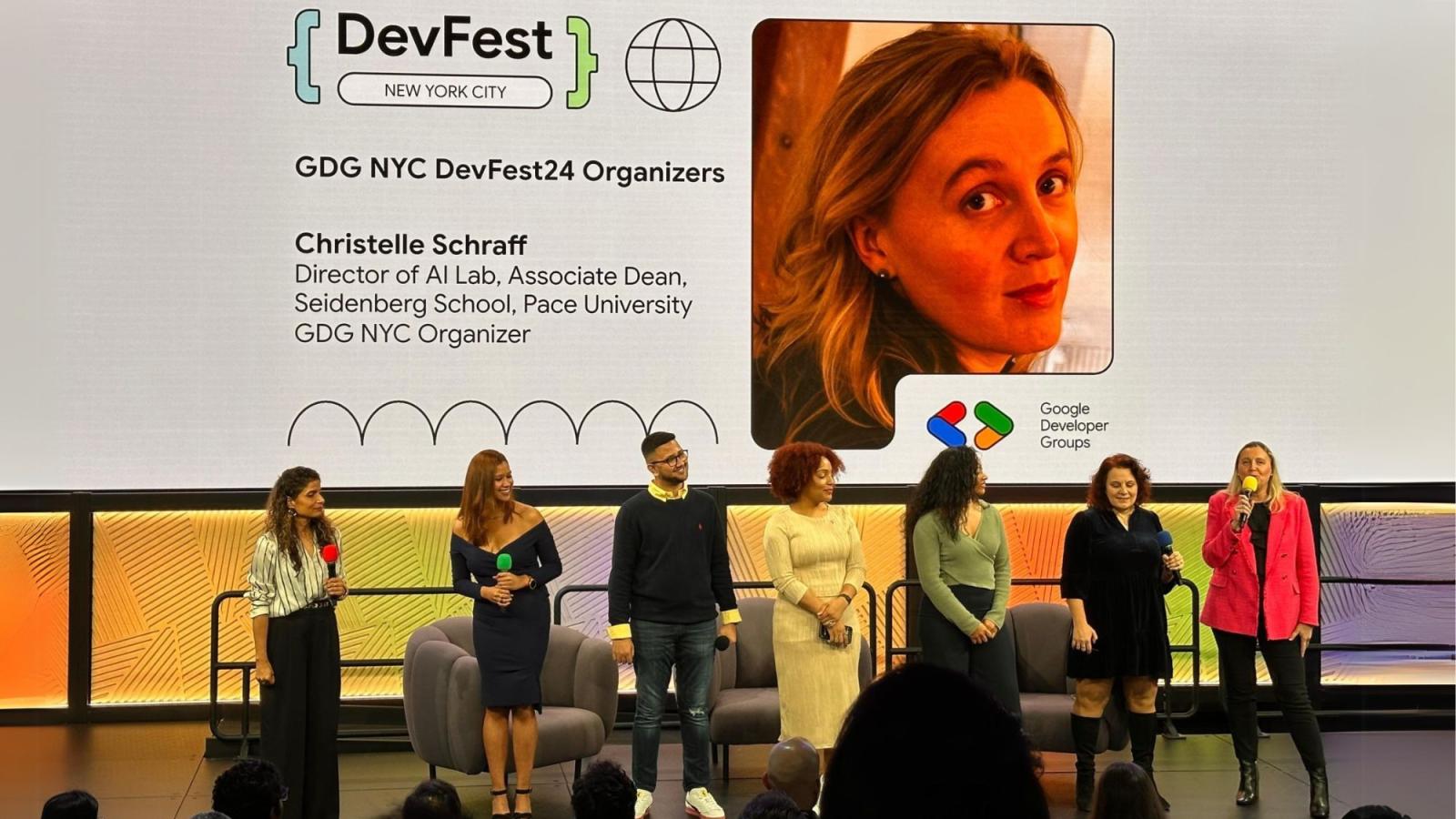
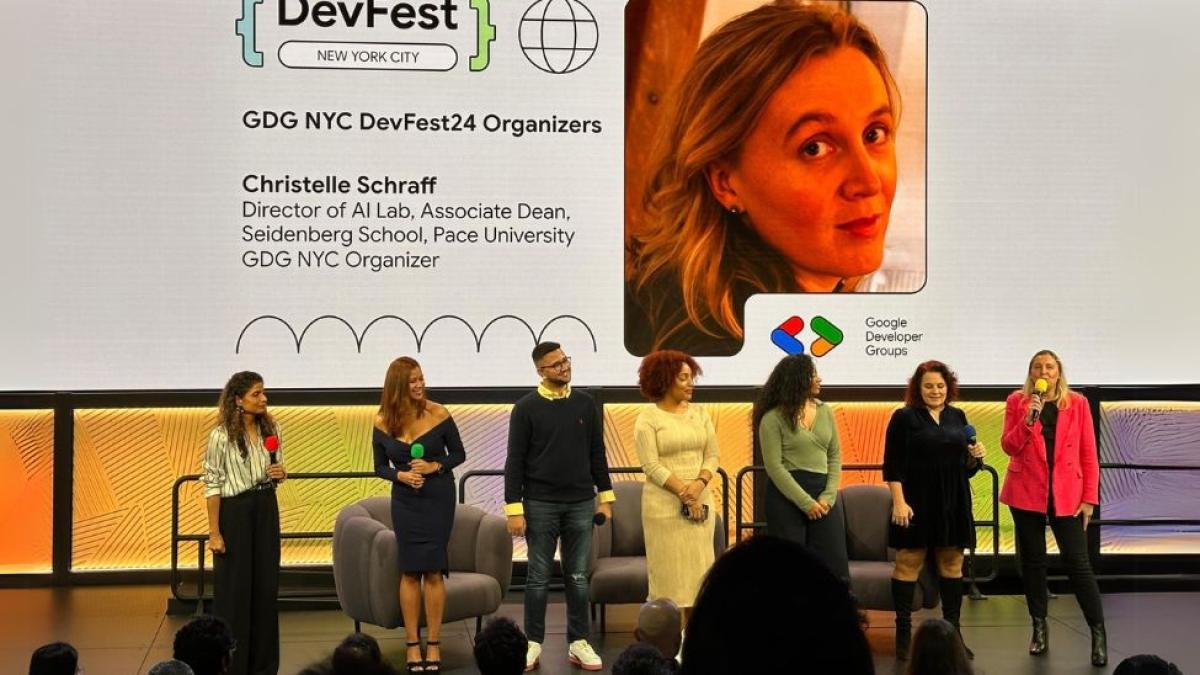
Google Pier 57 was recently full of energy as over 500 tech enthusiasts gathered for GDG DevFest NYC 2024, an event dedicated to exploring “Responsible AI for the Future of Tech.” Among the organizing team was Seidenberg Professor, Associate Dean, and Co-Director of the Pace AI Lab, Dr. Christelle Scharff, who collaborated with Google Developer Groups (GDG) over two months to curate a compelling agenda featuring Googlers and industry professionals.
The festival, organized by Google Developer Group NYC lead Anna Nerozova, highlighted robust ties between Pace University and the tech community. More than 50 Pace students attended, underscoring the university's and Seidenberg’s commitment to experiential learning and industry engagement. Notable moments included a keynote about responsible AI from Seidenberg Advisory Board member and Pace University Board of Trustees member Peta-Gay Clarke, who serves as the Global Community Programs Lead at Google. Dr. Scharff had the honor of introducing Clarke, while she also delivered an insightful lightning talk, “From Pixels to Fashion,” on her own research into AI and fashion, sparking conversations with students from Pace and beyond, including peers from NYU and Stevens Institute.
Seidenberg’s Lauren DeMaio, an MS in Computer Science student and leader of the Google Developer Student Club at Pace, introduced two of the event's speakers, further showing her dedication to bridging academic learning with industry practice. Seidenberg alum Bhavik Chopra, now a Data Analyst at Metropolitan Transportation Authority, was also heavily involved in organizing the event.
Reflecting on the event, Dr. Scharff shared that she was honored to be at the event among so many peers and students, and that “the collaboration and enthusiasm at GDG DevFest NYC reflect the dynamic future of AI and its role in shaping technology responsibly.”
GDG DevFest NYC exemplified the power of partnerships, knowledge-sharing, and hands-on learning. Seidenberg's presence not only highlighted the school’s leadership in tech education but also inspired students to actively engage in shaping the tech of tomorrow.
For more on Seidenberg's involvement in groundbreaking tech events, visit GDG DevFest NYC 2024.
Press Release: Pace University Receives $476K Mellon Foundation Grant to Advance Environmental Justice and Humanities
Pace University was recently awarded $476,000 from the Mellon Foundation to support a three-year interdisciplinary initiative, Islands, Archipelagos, and Cultural Ecologies. The project will advance environmental justice and the environmental humanities at Pace, building on the university’s strengths in experiential learning and place-based education.

Three-year project will explore themes of resilience, decolonization, and cultural ecologies
Pace University was recently awarded $476,000 from the Mellon Foundation to support a three-year interdisciplinary initiative, Islands, Archipelagos, and Cultural Ecologies. The project will advance environmental justice and the environmental humanities at Pace, building on the university’s strengths in experiential learning and place-based education.
The initiative will focus on developing an institutional identity for Pace’s lower Manhattan location as an island campus in New York City while connecting with other archipelagos in relationship with the United States. Through comparative studies of the islands of New York with the US legacy in the Marshall Islands and the territory of the US Virgin Islands the program will explore themes of vulnerability, responsibility, resilience, and decolonization.
“This grant provides an extraordinary opportunity for Pace University to deepen its leadership in environmental justice and interdisciplinary scholarship,” said Pace University President Marvin Krislov. “The Mellon Foundation’s support will enable us to harness the collective expertise of our faculty and students, bridging the humanities and environmental sciences to address urgent local and global issues.”
Led by a team of Pace faculty, the initiative includes Erica Johnson PhD, associate chairperson and professor of English; Emily Welty PhD, department chairperson and associate professor of the Peace and Justice Studies program; Matthew Bolton PhD, Political Science professor; Melanie DuPuis PhD, Environmental Studies and Science emeritus professor; and Katrina Fischer Kuh, Haub Distinguished Professor of Environmental Law.
“The Mellon Foundation grant underscores the humanities’ essential role in addressing critical global challenges,” said Tresmaine R. Grimes, Ph.D., dean of the Dyson College of Arts and Sciences and the School of Education. “This initiative highlights Pace’s leadership in experiential humanities, empowering students to explore resilience, decolonization, and cultural ecologies through innovative, place-based learning.”
The project is motivated by Pace’s recent participation in the Climate Exchange, a multi-institution initiative addressing climate challenges, and faculty research in environmental law, justice, and humanities. It will support activities such as faculty-mentored student research, curriculum development, and public engagement projects to address issues like waterfront planning, cultural production, and nuclear justice.
“The Elisabeth Haub School of Law has long been a leader in environmental law and justice,” said Horace Anderson Jr., J.D., dean of the Elisabeth Haub School of Law. “This initiative builds on our expertise in addressing the complex relationships between law, policy, and the environment, and it offers an unparalleled opportunity for interdisciplinary collaboration.”
“These themes—climate justice, creative interventions, and decolonization—reflect the core strengths of our faculty and the mission of Pace University,” said Johnson. “This initiative will amplify Pace’s role as a leader in environmental humanities and justice.”
The initiative aligns with Pace University’s commitment to experiential learning and interdisciplinary collaboration, creating opportunities for students and faculty to explore pressing global challenges while contributing to local communities.
About The Andrew W. Mellon Foundation
The Andrew W. Mellon Foundation is the nation’s largest supporter of the arts and humanities. Since 1969, the Foundation has been guided by its core belief that the humanities and arts are essential to human understanding. The Foundation believes that the arts and humanities are where we express our complex humanity, and that everyone deserves the beauty, transcendence, and freedom that can be found there. Through our grants, we seek to build just communities enriched by meaning and empowered by critical thinking, where ideas and imagination can thrive.
About Pace University
Since 1906, Pace University has been transforming the lives of its diverse students—academically, professionally, and socioeconomically. With campuses in New York City and Westchester County, Pace offers bachelor, master, and doctoral degree programs to 13,600 students in its College of Health Professions, Dyson College of Arts and Sciences, Elisabeth Haub School of Law, Lubin School of Business, Sands College of Performing Arts, School of Education, and Seidenberg School of Computer Science and Information Systems.
